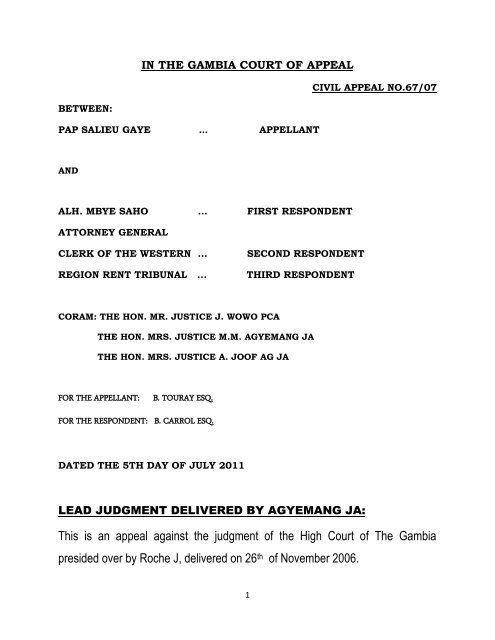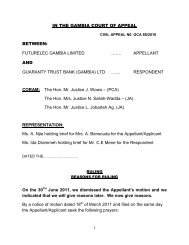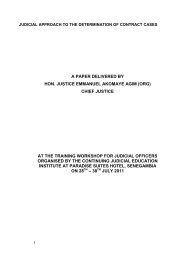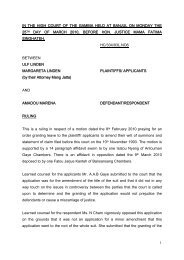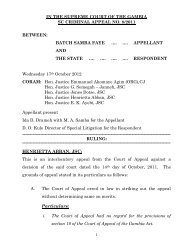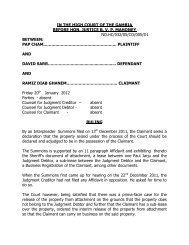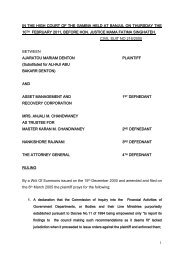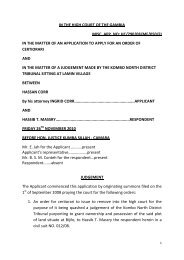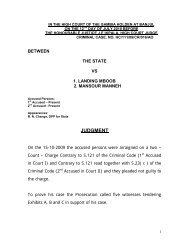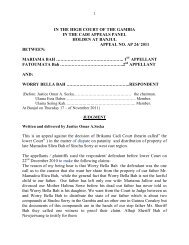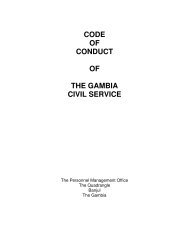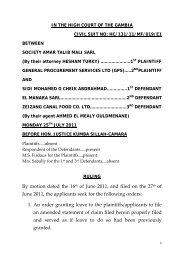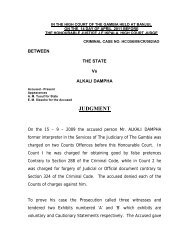This is an appeal against the judgment of the High Court of The ...
This is an appeal against the judgment of the High Court of The ...
This is an appeal against the judgment of the High Court of The ...
Create successful ePaper yourself
Turn your PDF publications into a flip-book with our unique Google optimized e-Paper software.
IN THE GAMBIA COURT OF APPEALCIVIL APPEAL NO.67/07BETWEEN:PAP SALIEU GAYE … APPELLANTANDALH. MBYE SAHO … FIRST RESPONDENTATTORNEY GENERALCLERK OF THE WESTERN ...REGION RENT TRIBUNAL ...SECOND RESPONDENTTHIRD RESPONDENTCORAM: THE HON. MR. JUSTICE J. WOWO PCATHE HON. MRS. JUSTICE M.M. AGYEMANG JATHE HON. MRS. JUSTICE A. JOOF AG JAFOR THE APPELLANT:B. TOURAY ESQ.FOR THE RESPONDENT: B. CARROL ESQ.DATED THE 5TH DAY OF JULY 2011LEAD JUDGMENT DELIVERED BY AGYEMANG JA:<strong>Th<strong>is</strong></strong> <strong>is</strong> <strong>an</strong> <strong>appeal</strong> <strong>against</strong> <strong>the</strong> <strong>judgment</strong> <strong>of</strong> <strong>the</strong> <strong>High</strong> <strong>Court</strong> <strong>of</strong> <strong>The</strong> Gambiapresided over by Roche J, delivered on 26 th <strong>of</strong> November 2006.1
<strong>The</strong> matters <strong>an</strong>tecedent to th<strong>is</strong> <strong>appeal</strong> are <strong>the</strong> following:<strong>The</strong> first respondent herein <strong>is</strong> <strong>the</strong> attorney <strong>of</strong> one Dodou Lait Saho h<strong>is</strong> bro<strong>the</strong>rfor whom he processed lease SR No. K 302/2000 in respect <strong>of</strong> l<strong>an</strong>d situate atOld Yundum. <strong>The</strong> appell<strong>an</strong>t herein <strong>is</strong> <strong>the</strong> occupier <strong>of</strong> a parcel <strong>of</strong> l<strong>an</strong>d at OldYundum which he alleged had been wrongfully taken up by <strong>the</strong> said lease. Forth<strong>is</strong> reason, <strong>the</strong> appell<strong>an</strong>t instituted <strong>an</strong> action <strong>against</strong> <strong>the</strong> first respondent at <strong>the</strong><strong>High</strong> <strong>Court</strong> seeking inter alia, declaration <strong>of</strong> title in respect <strong>of</strong> <strong>the</strong> same parcel <strong>of</strong>l<strong>an</strong>d alleging inter alia, fraud in <strong>the</strong> processing <strong>of</strong> <strong>the</strong> said lease. That action waspending when <strong>the</strong> first respondent commenced a suit <strong>against</strong> <strong>the</strong> appell<strong>an</strong>t at<strong>the</strong> Western Region Rent Tribunal for ejectment <strong>of</strong> <strong>the</strong> appell<strong>an</strong>t from <strong>the</strong> l<strong>an</strong>d. Itwas <strong>the</strong> case <strong>of</strong> <strong>the</strong> appell<strong>an</strong>t that on 9 th <strong>of</strong> May 2007, a summons from <strong>the</strong>Western Region Rent Tribunal was served in h<strong>is</strong> absence on h<strong>is</strong> wife. It was forhim to attend <strong>the</strong> next day, <strong>the</strong> 10 th <strong>of</strong> May 2007. In <strong>an</strong> affidavit sworn to by oneFaburama Jammeh on behalf <strong>of</strong> <strong>the</strong> appell<strong>an</strong>t at <strong>the</strong> court below in <strong>an</strong>application for leave to bring <strong>an</strong> application for certiorari, <strong>the</strong> said deponent whoalleged that he had <strong>the</strong> authority <strong>of</strong> both <strong>the</strong> appell<strong>an</strong>t <strong>an</strong>d h<strong>is</strong> counsel B. TourayEsq, alleged that <strong>the</strong> said summons was brought to counsel that day by oneDam Kumma. He deposed fur<strong>the</strong>r that counsel immediately wrote a letterexhibited as FJ2, to <strong>the</strong> Governor <strong>of</strong> <strong>the</strong> Western Region, informing him <strong>of</strong> <strong>the</strong>pendency at <strong>the</strong> <strong>High</strong> <strong>Court</strong> <strong>of</strong> a case involving <strong>the</strong> same subject matter <strong>an</strong>dbetween <strong>the</strong> same parties. Counsel also, in spite <strong>of</strong> <strong>the</strong> short notice went to <strong>the</strong>court <strong>the</strong> next day at 10.30 am to attend to <strong>the</strong> summons only to be informed by<strong>the</strong> clerk <strong>of</strong> court, that <strong>the</strong> matter had been called <strong>an</strong>d dealt with, <strong>judgment</strong>2
having been entered <strong>against</strong> <strong>the</strong> appell<strong>an</strong>t in h<strong>is</strong> absence. Counsel was alsoallegedly informed by one Momodou Lamin S<strong>an</strong>neh, <strong>the</strong> only member <strong>of</strong> <strong>the</strong>tribunal <strong>the</strong>n present, that <strong>judgment</strong> was entered not by <strong>the</strong> properly constitutedtribunal (for it had not sat that day), but by himself, sitting with <strong>the</strong> clerk <strong>of</strong> <strong>the</strong>tribunal. Counsel <strong>the</strong>n procured a photocopy <strong>of</strong> <strong>the</strong> day’s proceedings exhibitedas FJ3. <strong>The</strong>se, it was deposed, revealed that not only was <strong>the</strong> tribunal notproperly constituted, but that no evidence had been led in support <strong>of</strong> <strong>the</strong> claimfor ejectment. Thus did <strong>the</strong> appell<strong>an</strong>t as applic<strong>an</strong>t seek leave <strong>of</strong> <strong>the</strong> <strong>High</strong> <strong>Court</strong>to bring <strong>an</strong> application <strong>against</strong> <strong>the</strong> said tribunal for <strong>an</strong> order <strong>of</strong> certiorariquashing <strong>the</strong> <strong>judgment</strong> <strong>of</strong> <strong>the</strong> said tribunal.Leave having been gr<strong>an</strong>ted by <strong>the</strong> <strong>High</strong> <strong>Court</strong> presided over by Dordzie J, <strong>the</strong>appell<strong>an</strong>t brought <strong>an</strong> application for certiorari seeking <strong>an</strong> order for <strong>the</strong>proceedings <strong>of</strong> <strong>the</strong> 10 th <strong>of</strong> May 2007 before <strong>the</strong> Rent Tribunal, to be broughtbefore <strong>the</strong> <strong>High</strong> <strong>Court</strong> for <strong>the</strong> purpose <strong>of</strong> being quashed.<strong>The</strong> grounds <strong>of</strong> <strong>the</strong> application were <strong>the</strong> following:1. That <strong>the</strong>re was a patent error <strong>of</strong> law on <strong>the</strong> face <strong>of</strong> <strong>the</strong> record when<strong>judgment</strong> was entered for <strong>the</strong> respondent without calling him to prove h<strong>is</strong>claim;2. That <strong>the</strong> court lacked jur<strong>is</strong>diction because <strong>the</strong> tribunal was not properlyconstituted, <strong>the</strong> d<strong>is</strong>pute was <strong>the</strong> subject <strong>of</strong> a suit before <strong>the</strong> <strong>High</strong> <strong>Court</strong><strong>an</strong>d was one <strong>of</strong> title, not possession;3
3. That <strong>the</strong> tribunal failed to observe <strong>the</strong> principles <strong>of</strong> natural justice <strong>an</strong>d didnot give <strong>the</strong> appell<strong>an</strong>t a fair hearing when it did not give him <strong>the</strong>opportunity to be heard <strong>an</strong>d entered <strong>judgment</strong> for <strong>the</strong> first respondentwithout taking evidence;4. That <strong>the</strong> tribunal adopted <strong>the</strong> wrong procedure when without takingevidence, it entered <strong>judgment</strong> in favour <strong>of</strong> <strong>the</strong> first respondent.5. That <strong>the</strong> dec<strong>is</strong>ion <strong>of</strong> <strong>the</strong> tribunal was tainted with bias in that <strong>the</strong> appell<strong>an</strong>tas a member <strong>of</strong> <strong>the</strong> K<strong>an</strong>ifing Rent Tribunal enjoyed special treatment.During <strong>the</strong> arguments, <strong>the</strong> appell<strong>an</strong>t appeared to have ab<strong>an</strong>doned <strong>the</strong> lastground.After all arguments were heard from counsel for <strong>the</strong> parties, <strong>the</strong> learned trialjudge d<strong>is</strong>m<strong>is</strong>sed <strong>the</strong> application for <strong>the</strong> following reasons:That <strong>the</strong> certiorari application was a fresh action before <strong>the</strong> <strong>High</strong> <strong>Court</strong> whichwas already seized <strong>of</strong> <strong>an</strong> action involving <strong>the</strong> same subject matter in <strong>the</strong> suitnumbered HC/044/07/BK/004/AO. It was <strong>the</strong> view <strong>of</strong> <strong>the</strong> learned trial judgethat th<strong>is</strong> amounted to <strong>an</strong> abuse <strong>of</strong> <strong>the</strong> court’s process in that by <strong>the</strong>application, <strong>the</strong> <strong>High</strong> <strong>Court</strong> presided over by herself was being asked tousurp <strong>the</strong> powers <strong>of</strong> <strong>the</strong> judge dealing with suit numberedHC/044/07/BK/004/AO. <strong>The</strong> learned judge also held that <strong>the</strong> Rent Tribunalhad no jur<strong>is</strong>diction to determine title to l<strong>an</strong>d <strong>an</strong>d <strong>the</strong>refore <strong>the</strong> <strong>High</strong> <strong>Court</strong>seized with <strong>the</strong> matter could interfere with its dec<strong>is</strong>ion even where no <strong>appeal</strong>had been lodged or prerogative order sought. Thus did she maintain that <strong>the</strong>appell<strong>an</strong>t could have obtained <strong>the</strong> redress in what he sought, if he had4
applied to <strong>the</strong> <strong>High</strong> <strong>Court</strong> in that o<strong>the</strong>r suit for interim relief in accord<strong>an</strong>ce withOrder 12 Rules 1 <strong>an</strong>d 3 <strong>of</strong> <strong>the</strong> <strong>High</strong> <strong>Court</strong> Rules.It <strong>is</strong> <strong>against</strong> <strong>the</strong> said <strong>judgment</strong> that <strong>the</strong> present <strong>appeal</strong> has been lodged.In h<strong>is</strong> notice <strong>of</strong> <strong>appeal</strong>, <strong>the</strong> appell<strong>an</strong>t filed four grounds <strong>of</strong> <strong>appeal</strong> out <strong>of</strong> which heformulated two <strong>is</strong>sues. To <strong>the</strong>se <strong>the</strong> respondent added two o<strong>the</strong>r <strong>is</strong>sues fordetermination one <strong>of</strong> which because it overlaps <strong>an</strong>o<strong>the</strong>r, may be subsumedunder <strong>the</strong> appell<strong>an</strong>t’s <strong>is</strong>sues: <strong>The</strong>y are as follows:1. Whe<strong>the</strong>r or not <strong>the</strong> original jur<strong>is</strong>diction <strong>of</strong> <strong>the</strong> <strong>High</strong> <strong>Court</strong> <strong>an</strong>d <strong>the</strong>superv<strong>is</strong>ory jur<strong>is</strong>diction <strong>of</strong> <strong>the</strong> <strong>High</strong> <strong>Court</strong> are one <strong>an</strong>d <strong>the</strong> same as torun co-terminus in <strong>the</strong> same stream thus permitting <strong>the</strong> review powers<strong>of</strong> <strong>the</strong> <strong>High</strong> court to be exerc<strong>is</strong>ed in a suit commenced by a writ <strong>of</strong>summons;2. Whe<strong>the</strong>r or not <strong>the</strong> <strong>High</strong> <strong>Court</strong>, seized <strong>of</strong> a suit for a declaration <strong>of</strong> titleto l<strong>an</strong>d, lacks jur<strong>is</strong>diction to exerc<strong>is</strong>e its superv<strong>is</strong>ory jur<strong>is</strong>diction toquash <strong>an</strong> order <strong>of</strong> <strong>an</strong> inferior tribunal;3. Whe<strong>the</strong>r or not <strong>the</strong> appell<strong>an</strong>t was entitled to <strong>an</strong> order for certiorariunder <strong>the</strong> law.It seems to me that th<strong>is</strong> <strong>appeal</strong> c<strong>an</strong> be made short work <strong>of</strong> as <strong>the</strong> <strong>is</strong>sues aresufficiently simple.In <strong>the</strong> inst<strong>an</strong>t case, <strong>the</strong> appell<strong>an</strong>t as plaintiff had instituted <strong>an</strong> action fordeclaration <strong>of</strong> title before <strong>the</strong> <strong>High</strong> <strong>Court</strong>. It was while th<strong>is</strong> was pending that <strong>the</strong>first respondent also commenced <strong>an</strong> action on <strong>the</strong> same subject matter before<strong>the</strong> Western Region Rent Tribunal, admittedly seeking a different relief:5
ejectment. But <strong>the</strong> fact that <strong>the</strong> reliefs sought in <strong>the</strong> two forums were different,does not deny <strong>the</strong> fact that in gr<strong>an</strong>ting <strong>the</strong> relief sought by <strong>the</strong> first respondent,<strong>the</strong> first respondent’s remedy affected <strong>the</strong> suit before <strong>the</strong> <strong>High</strong> <strong>Court</strong>, for <strong>the</strong>execution <strong>of</strong> <strong>the</strong> order <strong>of</strong> ejectment would affect <strong>the</strong> appell<strong>an</strong>t’s right as a plaintiffin <strong>the</strong> suit for a declaration <strong>of</strong> title. It <strong>is</strong> my view that had all been properregarding <strong>the</strong> m<strong>an</strong>ner <strong>of</strong> <strong>the</strong> exerc<strong>is</strong>e <strong>of</strong> <strong>the</strong> court’s jur<strong>is</strong>diction, <strong>the</strong> appell<strong>an</strong>tmay have had little to complain about except with recourse to <strong>the</strong> appellateprocess. It would not have mattered in that circumst<strong>an</strong>ce if <strong>the</strong> appell<strong>an</strong>t whosecase was yet to be determined at <strong>the</strong> <strong>High</strong> <strong>Court</strong>, had been ejected by <strong>the</strong> order<strong>of</strong> <strong>the</strong> tribunal. <strong>The</strong> appell<strong>an</strong>t would have had a number <strong>of</strong> remedies whichincluded getting <strong>the</strong> default <strong>judgment</strong> set aside, or seeking a stay <strong>of</strong> executionfrom that court pending <strong>an</strong> <strong>appeal</strong> or perhaps, <strong>the</strong> determination <strong>of</strong> <strong>the</strong> <strong>High</strong><strong>Court</strong> suit. Certainly, it <strong>is</strong> my view that unless such redress was sought, contraryto what was held by <strong>the</strong> learned trial judge <strong>an</strong>d c<strong>an</strong>vassed in <strong>the</strong> firstrespondent’s brief, <strong>the</strong> <strong>High</strong> <strong>Court</strong> would lack <strong>the</strong> jur<strong>is</strong>diction to restrain <strong>the</strong> victor<strong>of</strong> a case decided within jur<strong>is</strong>diction, from enjoying <strong>the</strong> fruits <strong>of</strong> h<strong>is</strong> victory.But in th<strong>is</strong> case, what was sought before <strong>the</strong> <strong>High</strong> <strong>Court</strong> was <strong>an</strong> application forcertiorari upon grounds alleging inter alia, lack <strong>of</strong> jur<strong>is</strong>diction, <strong>an</strong> error on <strong>the</strong>face <strong>of</strong> <strong>the</strong> record, improper procedure, <strong>an</strong>d a breach <strong>of</strong> <strong>the</strong> rules <strong>of</strong> naturaljustice in respect <strong>of</strong> a matter heard by a lower adjudicatory body which althoughself-regulatory in terms <strong>of</strong> its procedure, was subject by its nature, to <strong>the</strong>observ<strong>an</strong>ce <strong>of</strong> <strong>the</strong> rules <strong>of</strong> natural justice <strong>an</strong>d limited by its statutorily-definedjur<strong>is</strong>diction.6
It seems to me that <strong>the</strong> learned trial judge erred in law when she failed toappreciate that <strong>the</strong> invocation <strong>of</strong> <strong>the</strong> superv<strong>is</strong>ory jur<strong>is</strong>diction <strong>of</strong> <strong>the</strong> court in noway undermined <strong>the</strong> court in <strong>the</strong> exerc<strong>is</strong>e <strong>of</strong> its original jur<strong>is</strong>diction.It <strong>is</strong> at th<strong>is</strong> point, apposite to set out <strong>the</strong> differences in <strong>the</strong> two jur<strong>is</strong>dictionsexerc<strong>is</strong>able by <strong>the</strong> <strong>High</strong> <strong>Court</strong>: <strong>The</strong> original jur<strong>is</strong>diction <strong>of</strong> <strong>High</strong> <strong>Court</strong> <strong>of</strong> <strong>The</strong>Gambia to hear <strong>an</strong>d determine civil criminal cases <strong>an</strong>d to interpret <strong>an</strong>d enforce<strong>the</strong> Constitution <strong>is</strong> set out under S. 132(1) <strong>of</strong> <strong>the</strong> Constitution <strong>of</strong> <strong>The</strong> Gambia. InS. 133 <strong>the</strong>re<strong>of</strong>, <strong>the</strong> framers <strong>of</strong> <strong>the</strong> Constitution set out <strong>the</strong> superv<strong>is</strong>ory jur<strong>is</strong>diction<strong>of</strong> <strong>the</strong> court. <strong>The</strong> two jur<strong>is</strong>dictions are vastly different from each o<strong>the</strong>r <strong>an</strong>d areaccessed or invoked in different circumst<strong>an</strong>ces <strong>an</strong>d for different outcomes, forwhilst <strong>the</strong> original jur<strong>is</strong>diction <strong>of</strong> <strong>the</strong> <strong>High</strong> <strong>Court</strong> empowers that court to entertainall matters civil, criminal <strong>an</strong>d constitutional brought before it by making adetermination <strong>the</strong>reon, final or interlocutory upon evidence adduced, <strong>the</strong>superv<strong>is</strong>ory jur<strong>is</strong>diction examines <strong>the</strong> process <strong>of</strong> adjudication <strong>an</strong>d <strong>is</strong> aimed, byits prerogative orders, at correcting <strong>the</strong> procedural errors in proceedings ininferior courts <strong>an</strong>d o<strong>the</strong>r adjudicatory bodies whe<strong>the</strong>r <strong>the</strong>y be judicial or quasijudicial.Certiorari <strong>is</strong> one such remedy by which <strong>the</strong> <strong>High</strong> <strong>Court</strong> in its d<strong>is</strong>cretion,may quash proceedings in a lower court or o<strong>the</strong>r body exerc<strong>is</strong>ing judicial orquasi-judicial functions where it fails to properly adjudicate a matter not in <strong>the</strong>subst<strong>an</strong>ce <strong>the</strong>re<strong>of</strong>, but in <strong>the</strong> m<strong>an</strong>ner <strong>the</strong>re<strong>of</strong>. <strong>The</strong> matters which ex<strong>is</strong>ting in <strong>an</strong>adjudication, may lead to <strong>the</strong> invocation <strong>of</strong>, <strong>an</strong>d <strong>the</strong> application <strong>of</strong> <strong>the</strong> said order<strong>of</strong> certiorari, include where <strong>the</strong>re <strong>is</strong> lack <strong>of</strong>, or excess <strong>of</strong> jur<strong>is</strong>diction, where rules<strong>of</strong> natural justice have been breached as in a person <strong>is</strong> not given a fair hearing,7
see: Republic v. <strong>High</strong> <strong>Court</strong>, Kumasi, Ex parte Appiah <strong>an</strong>d Ors [1997-98] 1GLR 503 SC.As aforesaid, <strong>the</strong> learned trial judge held (a matter which <strong>is</strong> c<strong>an</strong>vassed by <strong>the</strong>first respondent) that <strong>the</strong> appell<strong>an</strong>t could have sought redress in <strong>the</strong> suit alreadypending at <strong>the</strong> <strong>High</strong> <strong>Court</strong>. <strong>Th<strong>is</strong></strong> revealed a m<strong>is</strong>apprehension <strong>of</strong> <strong>the</strong> purpose <strong>an</strong>drole <strong>of</strong> judicial review, for she seemed to have laboured under <strong>the</strong>m<strong>is</strong>apprehension that what was sought was in <strong>the</strong> nature, or would have <strong>the</strong>same effect as <strong>an</strong> interim/interlocutory relief.<strong>The</strong> first respondent in h<strong>is</strong> brief has argued that no matter <strong>the</strong> form, <strong>the</strong> purpose<strong>of</strong> <strong>the</strong> application before <strong>the</strong> court was to stop execution or <strong>the</strong> fur<strong>the</strong>r execution<strong>of</strong> <strong>the</strong> order <strong>of</strong> <strong>the</strong> rent tribunal. Thus did he argue that it would have sufficed if<strong>the</strong> appell<strong>an</strong>t had obtained <strong>an</strong> interlocutory relief in <strong>the</strong> pending <strong>High</strong> <strong>Court</strong> case.To begin with, what <strong>the</strong> application sought was not a stay <strong>of</strong> execution but aquashing order <strong>of</strong> <strong>the</strong> <strong>High</strong> <strong>Court</strong> which would render non-est, <strong>the</strong> <strong>judgment</strong> <strong>of</strong>that court upon <strong>the</strong> grounds stated in <strong>the</strong> affidavit in support <strong>of</strong> <strong>the</strong> application.But beyond th<strong>is</strong>, <strong>the</strong> error <strong>of</strong> th<strong>is</strong> argument <strong>is</strong> that it fails to appreciate that <strong>the</strong><strong>High</strong> <strong>Court</strong> did not, while exerc<strong>is</strong>ing its own original jur<strong>is</strong>diction, have <strong>the</strong>jur<strong>is</strong>diction in that exerc<strong>is</strong>e, to stop execution <strong>of</strong> a <strong>judgment</strong> entered by a bodyacting within its jur<strong>is</strong>diction, no matter how much <strong>of</strong> <strong>an</strong> inconvenience it was to itor to <strong>the</strong> parties. But even if as argued by learned counsel, <strong>an</strong> interlocutory reliefwould have had <strong>the</strong> effect <strong>of</strong> stopping execution, what <strong>the</strong>n would have been <strong>the</strong>status <strong>of</strong> <strong>the</strong> <strong>judgment</strong> <strong>of</strong> that o<strong>the</strong>r body when same had not been set aside? It8
must be noted that <strong>the</strong> claim decided by <strong>the</strong> tribunal was one <strong>of</strong> ejectment <strong>an</strong>dwithin its jur<strong>is</strong>diction.Would <strong>the</strong> <strong>judgment</strong> <strong>of</strong> <strong>the</strong> rent tribunal given within jur<strong>is</strong>diction cease to ex<strong>is</strong>tbecause <strong>of</strong> <strong>the</strong> <strong>High</strong> <strong>Court</strong>’s orders given as <strong>an</strong> interim/interlocutory measureunder Order 12 rules 1 <strong>an</strong>d 3 as postulated by <strong>the</strong> learned trial judge? Mostcertainly not.It <strong>is</strong> my view that <strong>the</strong> arguments <strong>of</strong> learned counsel for <strong>the</strong> respondent,regarding <strong>the</strong> effect <strong>of</strong> obtaining <strong>an</strong> interlocutory order in <strong>the</strong> pending <strong>High</strong> <strong>Court</strong>case, did not consider <strong>the</strong> status <strong>of</strong> <strong>the</strong> yet subs<strong>is</strong>ting <strong>judgment</strong> <strong>of</strong> <strong>the</strong> renttribunal (which <strong>the</strong> appell<strong>an</strong>t alleged had been entered without jur<strong>is</strong>diction) evenif <strong>the</strong> <strong>High</strong> <strong>Court</strong>’s interlocutory order succeeded in holding it in abey<strong>an</strong>ce. That<strong>judgment</strong> irregular or not, would subs<strong>is</strong>t <strong>an</strong>d be executable.Unfortunate also, was <strong>the</strong> trial court’s holding that as long as <strong>the</strong> rent tribunalhad no jur<strong>is</strong>diction to determine title, <strong>the</strong> <strong>High</strong> <strong>Court</strong> did not need its appellatejur<strong>is</strong>diction or <strong>the</strong> exerc<strong>is</strong>e <strong>of</strong> its superv<strong>is</strong>ory jur<strong>is</strong>diction invoked to be able tointerfere with it. <strong>Th<strong>is</strong></strong> was wrong in law, for it c<strong>an</strong>not be gainsaid that even awrong <strong>judgment</strong>/order subs<strong>is</strong>ts until it <strong>is</strong> set aside, see: Asin Apem<strong>an</strong>im LocalCouncil v. Williamson [1965] GLR 18.Learned counsel for <strong>the</strong> first respondent in supporting <strong>the</strong> ruling <strong>of</strong> <strong>the</strong> courtbelow, c<strong>an</strong>vassed <strong>the</strong> alleged impropriety <strong>of</strong> <strong>the</strong> application for certiorari while asuit was pending before <strong>the</strong> <strong>High</strong> <strong>Court</strong> <strong>an</strong>d relied on <strong>the</strong> plea <strong>of</strong> l<strong>is</strong> alibipendens. In that regard, he relied on <strong>the</strong> Gh<strong>an</strong>ai<strong>an</strong> case <strong>of</strong> Kumah v. Ankoma9
[1972] 2 GLR 134. But <strong>the</strong> said case must be respectfully d<strong>is</strong>tingu<strong>is</strong>hed from <strong>the</strong>present inst<strong>an</strong>ce.As a self-regulatory measure, <strong>the</strong> courts generally frown upon a multiplicity <strong>of</strong>suits. Thus will <strong>the</strong> court before which a case <strong>is</strong> brought, frown upon it, should itbe brought to its attention that a suit between <strong>the</strong> same parties, on <strong>the</strong> samesubject matter, <strong>is</strong> brought by <strong>the</strong> same person, before that court or in <strong>an</strong>o<strong>the</strong>rcourt. When th<strong>is</strong> happens, <strong>the</strong> party who st<strong>an</strong>ds to be prejudiced <strong>the</strong>reby mayra<strong>is</strong>e a plea <strong>of</strong> l<strong>is</strong> aibi pendens <strong>an</strong>d upon demonstrating that <strong>the</strong> two or moresuits are concurrent <strong>an</strong>d vex him, will have <strong>the</strong> suit brought <strong>against</strong> him stayedto abide <strong>the</strong> result <strong>of</strong> <strong>the</strong> former suit, or struckout depending on <strong>the</strong>circumst<strong>an</strong>ces, see per Baidoo J in Kumah v. Ankoma (supra): “<strong>The</strong> cardinalrule <strong>is</strong> that a plea <strong>of</strong> l<strong>is</strong> alibi pendens will not succeed unless <strong>the</strong> applic<strong>an</strong>tproves as a matter <strong>of</strong> fact that <strong>the</strong> action instituted by <strong>the</strong> plaintiff <strong>is</strong> vexatious in<strong>the</strong> sense that he <strong>the</strong> applic<strong>an</strong>t <strong>is</strong> doubly <strong>an</strong>d unnecessarily vexed by reason <strong>of</strong><strong>an</strong>o<strong>the</strong>r action for <strong>the</strong> same cause <strong>of</strong> action which has been instituted in <strong>an</strong>o<strong>the</strong>rcourt between <strong>the</strong> same parties” see also: per Jessel MR in MacHenry v. Lew<strong>is</strong>(1883) 22 Ch. D 397at 400: “...where two actions are by <strong>the</strong> same m<strong>an</strong> in courtsgoverned by <strong>the</strong> same procedure, <strong>an</strong>d where <strong>the</strong> <strong>judgment</strong>s are followed by <strong>the</strong>same remedies, it <strong>is</strong> prima facie vexatious to bring two actions when one willdo”. <strong>The</strong>se dicta represent <strong>the</strong> foundation <strong>of</strong> <strong>the</strong> plea. <strong>The</strong> plea has no placewhere a party who commences <strong>an</strong> action for <strong>the</strong> vindication for h<strong>is</strong> right, invokes<strong>the</strong> superv<strong>is</strong>ory jur<strong>is</strong>diction <strong>of</strong> <strong>the</strong> court regarding <strong>the</strong> proceedings <strong>of</strong> <strong>an</strong> inferiortribunal upon grounds such as patent error or lack <strong>of</strong> jur<strong>is</strong>diction. What <strong>the</strong>10
application was aimed at, was a quashing <strong>of</strong> proceedings upon grounds that<strong>the</strong>y were irregularly held in that <strong>the</strong>y inter alia, did not observe <strong>the</strong> rules <strong>of</strong>natural justice. That suit which was directed at <strong>the</strong> proceedings <strong>of</strong> a loweradjudicatory body, was essentially different from <strong>the</strong> pending suit at <strong>the</strong> <strong>High</strong><strong>Court</strong> that sought a declaration <strong>of</strong> title. Indeed, even <strong>the</strong> parties were not <strong>the</strong>same, for whereas <strong>the</strong> former was a state proceeding <strong>an</strong>d cited <strong>the</strong> tribunal <strong>an</strong>d<strong>the</strong> Government’s legal representative as well as <strong>the</strong> first respondent, <strong>the</strong> latterwhich was in <strong>the</strong> domain <strong>of</strong> private law was only <strong>against</strong> <strong>the</strong> first respondent.Nor was it a fresh action, as <strong>the</strong> learned trial judge pronounced it to be. Unlike<strong>the</strong> action for a declaration <strong>of</strong> title, th<strong>is</strong> was <strong>an</strong> application for a prerogative orderto <strong>is</strong>sue <strong>an</strong>d <strong>the</strong>re <strong>is</strong> a world <strong>of</strong> difference between <strong>the</strong> two. <strong>The</strong> plea <strong>of</strong> l<strong>is</strong> alibipendens thus did not ar<strong>is</strong>e, <strong>an</strong>d <strong>the</strong> arguments <strong>an</strong>d case cited for <strong>the</strong> persuasion<strong>of</strong> th<strong>is</strong> court were utterly inapplicable. I might add that in <strong>an</strong>y case, that wasnever <strong>the</strong> case <strong>of</strong> <strong>the</strong> first respondent at <strong>the</strong> court a quo.As aforesaid, contrary to <strong>the</strong> holding <strong>of</strong> <strong>the</strong> trial judge, <strong>the</strong> <strong>High</strong> <strong>Court</strong> seized with<strong>the</strong> suit for a declaration <strong>of</strong> title was in no position in that proceeding, to interferewith <strong>the</strong> <strong>judgment</strong> <strong>of</strong> <strong>the</strong> tribunal under <strong>an</strong>y circumst<strong>an</strong>ce, including <strong>the</strong> exerc<strong>is</strong>e<strong>of</strong> its superv<strong>is</strong>ory jur<strong>is</strong>diction. <strong>The</strong> reason <strong>is</strong> as has been reiterated: <strong>the</strong> twojur<strong>is</strong>dictions were different <strong>an</strong>d mutually exclusive.Although <strong>the</strong> appell<strong>an</strong>t limited himself to <strong>the</strong> ruling <strong>of</strong> <strong>the</strong> court below that deniedhim <strong>the</strong> order sought upon <strong>the</strong> grounds stated, <strong>the</strong> respondent in h<strong>is</strong> briefargued extensively as to why <strong>the</strong> order <strong>of</strong> certiorari would not have succeededon its merits. He thus set out <strong>the</strong> matter as <strong>an</strong> <strong>is</strong>sue for determination which11
moves th<strong>is</strong> court thus to consider <strong>the</strong> merits <strong>of</strong> <strong>the</strong> case before <strong>the</strong> court below.Should <strong>the</strong> appell<strong>an</strong>t have succeeded in h<strong>is</strong> application for certiorari? It seemsto me that he was entitled to <strong>the</strong> order for <strong>the</strong> reasons I will set out shortly.<strong>The</strong> applic<strong>an</strong>t set out <strong>the</strong> following four complaints regarding <strong>the</strong> proceedingsbefore <strong>the</strong> tribunal:That <strong>the</strong> tribunal failed to observe <strong>the</strong> principles <strong>of</strong> natural justice <strong>an</strong>d did notgive <strong>the</strong> appell<strong>an</strong>t a fair hearing for he was not given <strong>an</strong> opportunity to be heard,that <strong>the</strong>re was a patent error <strong>of</strong> law on <strong>the</strong> face <strong>of</strong> <strong>the</strong> record when <strong>judgment</strong>was entered for <strong>the</strong> respondent without calling him to prove h<strong>is</strong> claim; that <strong>the</strong>tribunal adopted <strong>the</strong> wrong procedure when it gave <strong>judgment</strong> without takingevidence, that <strong>an</strong>d lastly, that <strong>the</strong> court lacked jur<strong>is</strong>diction because apart from<strong>the</strong> fact that <strong>the</strong> tribunal was not properly constituted, <strong>the</strong> d<strong>is</strong>pute was <strong>the</strong>subject <strong>of</strong> a suit before <strong>the</strong> <strong>High</strong> <strong>Court</strong> <strong>an</strong>d was one <strong>of</strong> title, not possession.I will d<strong>is</strong>cuss <strong>the</strong>m in that order. Regarding <strong>the</strong> charge that <strong>the</strong> appell<strong>an</strong>t wasnot given a fair hearing, I am not persuaded that th<strong>is</strong> obtained. On <strong>the</strong> adm<strong>is</strong>sion<strong>of</strong> <strong>the</strong> appell<strong>an</strong>t, service was effected on <strong>an</strong> adult inmate in h<strong>is</strong> house. <strong>Th<strong>is</strong></strong> wasnot, as c<strong>an</strong>vassed by learned counsel for <strong>the</strong> appell<strong>an</strong>t, unauthor<strong>is</strong>ed substitutedservice. Because <strong>the</strong> tribunal’s enabling Act did not set out what would bedeemed to be personal service, I will, for guid<strong>an</strong>ce, call in aid S. 4 (8) <strong>of</strong> <strong>the</strong>Subordinate <strong>Court</strong>s (Civil Proceedings) Rules Cap 8:03 which prescribedpersonal service to include service on <strong>an</strong> inmate <strong>of</strong> <strong>the</strong> place <strong>of</strong> <strong>the</strong> defend<strong>an</strong>t’sabode who was above sixteen years old.12
<strong>The</strong> summons comm<strong>an</strong>ded <strong>the</strong> appell<strong>an</strong>t to appear at 10.00am <strong>the</strong> next day. Itwas <strong>the</strong> appell<strong>an</strong>t’s showing that <strong>the</strong> summons upon due service, m<strong>an</strong>aged toget h<strong>is</strong> attorney to attend, albeit half <strong>an</strong> hour later th<strong>an</strong> was comm<strong>an</strong>ded. That inmy view sufficed for <strong>an</strong> appear<strong>an</strong>ce although it would certainly have beenpreferable if he had been given more time th<strong>an</strong> he was, or if <strong>the</strong> tribunal hadbeen guided by time limits before <strong>the</strong> subordinate court which was three daysbefore <strong>the</strong> hearing <strong>of</strong> <strong>the</strong> summons. But to say service was short <strong>an</strong>d <strong>the</strong>reforebad, was to say that it fell short <strong>of</strong> <strong>the</strong> requ<strong>is</strong>ite period. It must however be notedthat <strong>the</strong> tribunal which by statute, <strong>is</strong> vested with <strong>the</strong> jur<strong>is</strong>diction to regulate itsown procedures, see: S. 7(5) <strong>of</strong> <strong>the</strong> Rent Decree 1996, was not subject to Cap8:02 (supra), <strong>an</strong>d <strong>the</strong> time limits <strong>the</strong>rein prescribed for <strong>the</strong> regulation <strong>of</strong> <strong>the</strong>proceedings <strong>of</strong> such courts was inapplicable to <strong>the</strong> tribunal, see S. 5 <strong>the</strong>re<strong>of</strong>.<strong>The</strong> tribunal, set up under, <strong>the</strong> Rent Decree 1996, <strong>is</strong> by <strong>the</strong> combined effect <strong>of</strong>Ss. 6(1) 2 nd Schedule <strong>an</strong>d 120 (b) <strong>of</strong> <strong>the</strong> Constitution, a court in <strong>The</strong> Gambia.It <strong>is</strong> however not <strong>the</strong> subordinate court governed by <strong>the</strong> said Cap 8:02, because<strong>the</strong> jur<strong>is</strong>diction <strong>of</strong> <strong>the</strong> subordinate court contained in S.3 <strong>of</strong> <strong>the</strong> Act, differs fromthat <strong>of</strong> <strong>the</strong> rent tribunal which, like <strong>the</strong> D<strong>is</strong>trict Tribunal, has its jur<strong>is</strong>diction <strong>is</strong>provided for under its enabling Act, (in th<strong>is</strong> case <strong>the</strong> Rent Decree). Because <strong>of</strong>its adjudicatory function, it was bound to act judicially in its proceedings. <strong>Th<strong>is</strong></strong>included its duty to ensure that parties before it were given reasonable notice <strong>of</strong>hearing to afford <strong>the</strong>m <strong>the</strong> opportunity <strong>of</strong> appearing to make <strong>the</strong>ir case before it.It was thus sufficient to meet its duty <strong>of</strong> acting judicially, once it wasdemonstrated that <strong>the</strong>re had been service <strong>of</strong> its notice <strong>of</strong> hearing to parties13
appearing before it. <strong>Th<strong>is</strong></strong> was met when due service was acknowledged by <strong>the</strong>appell<strong>an</strong>t in h<strong>is</strong> supporting affidavit before <strong>the</strong> court below.Regarding <strong>the</strong> two grounds which alleged that no evidence was led by <strong>the</strong>plaintiff before <strong>the</strong> tribunal before <strong>judgment</strong> was entered for him, it seems to methat although <strong>the</strong>re was no prescribed mode under <strong>the</strong> Rent Decree which<strong>the</strong>refore could not be said to be <strong>an</strong> infraction resulting in <strong>an</strong> error patent on <strong>the</strong>record, <strong>the</strong> taking <strong>of</strong> evidence before <strong>the</strong> entry <strong>of</strong> default <strong>judgment</strong> <strong>is</strong> more inaccord with <strong>the</strong> judicial st<strong>an</strong>dard <strong>an</strong>d should have obtained in <strong>the</strong> presentinst<strong>an</strong>ce.Regarding <strong>the</strong> matter <strong>of</strong> jur<strong>is</strong>diction also, it seems to me that <strong>the</strong> proceedingsthat culminated in a <strong>judgment</strong> <strong>against</strong> <strong>the</strong> appell<strong>an</strong>t were indeed conductedwithout jur<strong>is</strong>diction <strong>an</strong>d it <strong>is</strong> not because <strong>the</strong> same matter was pending before<strong>the</strong> <strong>High</strong> <strong>Court</strong>. No doubt <strong>the</strong> case pending at <strong>the</strong> <strong>High</strong> <strong>Court</strong> was between <strong>the</strong>same parties <strong>an</strong>d involved <strong>the</strong> same subject matter which was l<strong>an</strong>d situate at oldYundum. It <strong>is</strong> a fact however that <strong>the</strong> cause <strong>of</strong> action before <strong>the</strong> <strong>High</strong> <strong>Court</strong> wasone <strong>of</strong> title to l<strong>an</strong>d <strong>an</strong>d that before <strong>the</strong> rent tribunal was one <strong>of</strong> ejectment upon<strong>an</strong> allegation <strong>of</strong> failure to pay rent. <strong>The</strong> rent tribunal, by Ss. 20 (6) <strong>an</strong>d (7) <strong>an</strong>d 24<strong>of</strong> <strong>the</strong> Rent Tribunal Decree, had <strong>the</strong> jur<strong>is</strong>diction to entertain l<strong>an</strong>dlord <strong>an</strong>d ten<strong>an</strong>tsuits <strong>an</strong>d in particular, actions for ejectment under S. 20(6) <strong>the</strong>re<strong>of</strong>. I reproduce<strong>the</strong> said prov<strong>is</strong>ions:20 (6) “When a tribunal refuses to make <strong>an</strong> order on <strong>an</strong> application under th<strong>is</strong> section,a ten<strong>an</strong>t, after <strong>the</strong> expiry <strong>of</strong> <strong>the</strong> termination date refuses to give up possession <strong>of</strong> aproperty, <strong>the</strong> tribunal may, on <strong>an</strong> application by <strong>the</strong> l<strong>an</strong>dlord, make <strong>an</strong> ejectmentorder <strong>against</strong> <strong>the</strong> ten<strong>an</strong>t...”14
24: “A d<strong>is</strong>pute between a l<strong>an</strong>dlord <strong>an</strong>d ten<strong>an</strong>t shall, not withst<strong>an</strong>ding <strong>an</strong>y o<strong>the</strong>r cause<strong>of</strong> action available to <strong>the</strong>m in law, be referred to a tribunal for adjudication <strong>an</strong>d <strong>the</strong>dec<strong>is</strong>ion <strong>of</strong> <strong>the</strong> tribunal shall be final <strong>an</strong>d binding between <strong>the</strong> parties...”<strong>The</strong>re was thus no conflict between a suit for ejectment between <strong>an</strong> allegedl<strong>an</strong>dlord <strong>an</strong>d h<strong>is</strong> ten<strong>an</strong>t being heard by <strong>the</strong> tribunal in <strong>the</strong> proper exerc<strong>is</strong>e <strong>of</strong> itsjur<strong>is</strong>diction in <strong>the</strong> circumst<strong>an</strong>ce where a suit, not seeking ejectment, but seekinga declaration <strong>of</strong> title was pending at <strong>the</strong> <strong>High</strong> <strong>Court</strong>. It most certainly was not acircumst<strong>an</strong>ce for which <strong>an</strong> order <strong>of</strong> certiorari may be gr<strong>an</strong>ted.<strong>The</strong> appell<strong>an</strong>t as applic<strong>an</strong>t before <strong>the</strong> court below also alleged that <strong>the</strong> tribunalthat entered <strong>judgment</strong> <strong>against</strong> <strong>the</strong> appell<strong>an</strong>t was not properly constituted. <strong>Th<strong>is</strong></strong>was contained in <strong>the</strong> affidavit sworn to by Faburama Jammeh in support <strong>of</strong> <strong>the</strong>application for certiorari <strong>an</strong>d supported by <strong>the</strong> photocopy <strong>of</strong> <strong>the</strong> proceedings <strong>of</strong>that day. Learned counsel for <strong>the</strong> first respondent has alleged that <strong>the</strong> saiddeposition sinned <strong>against</strong> Ss 91 <strong>an</strong>d 92 <strong>of</strong> <strong>the</strong> Evidence Act 1994. I could notd<strong>is</strong>agree more. It seems to be that <strong>the</strong> said deposition by Faburama Jammehwho stated h<strong>is</strong> source <strong>of</strong> information to be counsel et al, sufficiently compliedwith <strong>the</strong> said prov<strong>is</strong>ions. <strong>The</strong> said averment was never denied. <strong>Th<strong>is</strong></strong> court has ontwo previous occasions taken differing positions on <strong>the</strong> status <strong>of</strong> <strong>an</strong> averment in<strong>an</strong> affidavit which <strong>is</strong> not denied. But <strong>the</strong>re <strong>is</strong> a weight <strong>of</strong> judicial opinion in favour<strong>of</strong> <strong>the</strong> holding <strong>of</strong> th<strong>is</strong> court that failure to deny a deposition in <strong>an</strong> affidavit unlikein a pleading, does not necessarily constitute <strong>an</strong> adm<strong>is</strong>sion <strong>of</strong> <strong>the</strong> truth <strong>the</strong>re<strong>of</strong>,<strong>an</strong>d I will accept that as <strong>the</strong> position in th<strong>is</strong> regard, see per Chomba P in Carrolv. Carrol [1997 - 2001] 339 GR at 349. Even so, it <strong>is</strong> my view that in <strong>the</strong>15
present inst<strong>an</strong>ce where <strong>the</strong> name <strong>of</strong> <strong>the</strong> person who allegedly gave thatinformation was provided in <strong>the</strong> affidavit, he could it seems to me at <strong>the</strong> veryleast, have sworn to <strong>an</strong> affidavit denying <strong>the</strong> said averment. In <strong>the</strong> circumst<strong>an</strong>cewhere no such denial obtained, it seems to me reasonable to assume that it wasbecause <strong>the</strong>re was no contrary position. Although <strong>the</strong> document FJ3 which wasexhibited by <strong>the</strong> appell<strong>an</strong>t was not certified by <strong>the</strong> <strong>of</strong>fice from which it wasproduced <strong>an</strong>d was thus <strong>of</strong> no probative value as without au<strong>the</strong>ntication, it sinned<strong>against</strong> S. 113 <strong>of</strong> <strong>the</strong> Evidence Act 1994 (<strong>an</strong>d in <strong>an</strong>y case did not d<strong>is</strong>close suchlack <strong>of</strong> quorum as was being alleged), it seems to me that <strong>the</strong> unchallengedaverment in <strong>the</strong> affidavit that named a particular member as having sat alone toenter <strong>judgment</strong> leaves me with no o<strong>the</strong>r conclusion th<strong>an</strong> that <strong>the</strong> failure to denymust be taken as <strong>an</strong> adm<strong>is</strong>sion <strong>of</strong> <strong>the</strong> truth <strong>of</strong> <strong>the</strong> averment. <strong>The</strong> Rent Tribunalwas thus not properly constituted when one, instead <strong>of</strong> <strong>the</strong> three membersprescribed under its enabling Act, sat to determine <strong>the</strong> case brought <strong>against</strong> <strong>the</strong>appell<strong>an</strong>t <strong>an</strong>d entered <strong>judgment</strong> <strong>against</strong> him, see S.7(2) <strong>of</strong> <strong>the</strong> Rent Decree,1996.It <strong>is</strong> my view <strong>the</strong>n that on <strong>the</strong> sole ground <strong>of</strong> lack <strong>of</strong> jur<strong>is</strong>diction, <strong>the</strong> appell<strong>an</strong>twas entitled to <strong>the</strong> order he sought <strong>an</strong>d <strong>the</strong> court below should not havedeprived him <strong>of</strong> it as <strong>the</strong> learned trial judge did, citing in error, technical rulesthat had no application in <strong>the</strong> matter.<strong>The</strong> <strong>appeal</strong> <strong>is</strong> thus hereby allowed <strong>an</strong>d <strong>the</strong> ruling <strong>of</strong> Roche J <strong>of</strong> <strong>the</strong> 26 th <strong>of</strong>November 2007 <strong>is</strong> hereby set aside.16
Costs <strong>of</strong> D25,000 to <strong>the</strong> appell<strong>an</strong>t.M.M. AGYEMANG JAI AGREEJ. WOWO PCAI ALSO AGREEA. JOOF AG JA17


